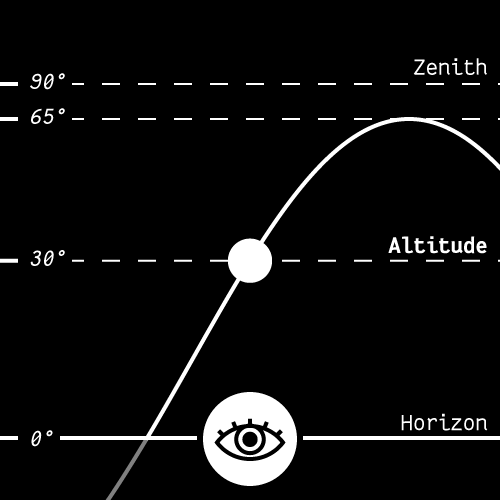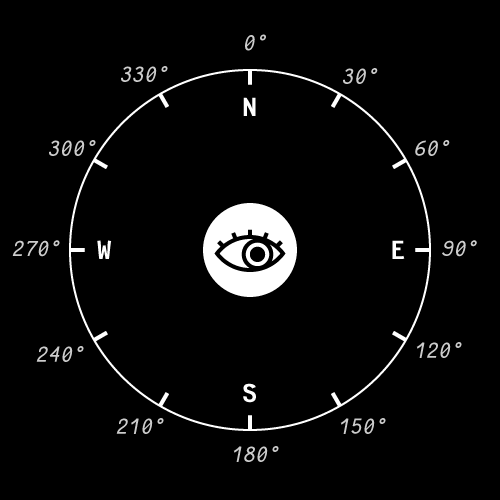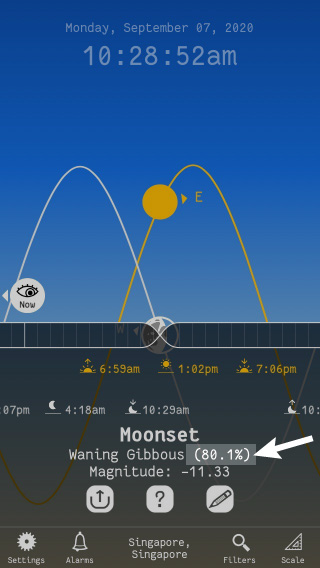Have a question that isn’t answered here? Drop us a line at contact@digitalsundries.org.
The curve in Suntime represents the altitude, or height, of the Sun and Moon over time.
The heights of the Sun and Moon change throughout the year due to Earth’s elliptical orbit and tilted axis. Away from the equator, the Sun is highest in the summer, and lowest in the winter.
 |  |
| Altitude (or Elevation): height of object in the sky, measured in the angle from the horizon. | In Suntime the height of an object in the sky is graphed over time. |
The headings next to the Sun and Moon tell you where in the sky to look for each body.
Depending on your time and location, the Sun and Moon appear in different quadrants of the sky. In Suntime, you can display this as either as a compass heading, or azimuth in degrees.
 |  |
| Heading (or Direction): The compass direction of an object in the sky. In Suntime there are eight headings: N, NE, E, SE, S, SW, W, and NW. | Azimuth: The direction of objects in the sky can also be measured as an angle from due North. Similar to a compass heading, but expressed in 360 degrees with North at 0°. |
 |
| (%): The percentage of the Moon’s face that is currently illuminated by sunlight. |
By definition when the Moon is full, it is 100% illuminated. When the Moon is new, it is 0% illuminated. When the Moon is in it’s first or last quarter, it is 50% illuminated.
Since these four phases are known, the percentage illumination is only displayed whenever the phase is something other than new, full, first or last quarter.
Apparent magnitude measures the brightness of an object (in this case the Moon) as observed from the Earth.
 |
| Apparent Magnitude: The brightness of the Moon. |
The lower the magnitude, the brighter the object: the Sun measures around -27, Full Moon around -13, and Venus at its brightest around -5.
The brightest star in the sky, Sirius, has a magnitude of -1. Objects above a magnitude of +6 are difficult to see with the naked eye.
Twilight happens twice each day. Suntime shows three subcategories of twilight defined by the Sun’s elevation compared to the horizon: Civil (closest to horizon), Nautical, and Astronomical (furthest from horizon).

In the morning, twilight begins at dawn and progresses from astronomical twilight, to nautical twilight, to civil twilight, ending at sunrise. In the evening, the twilights occur in reverse order from sunset to dusk.
See the glossary definitions for morning twilight and evening twilight for more details.
 | Sunrise: When the sun appears above the horizon. Twilight ends. |
 | Solar Noon / Sun Transit: When the sun reaches its highest position in the sky. AKA local noon, different from civil noon, which is 12:00 PM. |
 | Sunset: When the sun disappears below the horizon. Twilight begins. |
 | Moonrise: When the moon appears above the horizon. |
 | Lunar Noon / Moon Transit: When the moon reaches its highest position in the sky. |
 | Moonset: When the moon disappears below the horizon. |
 | New Moon: The first phase in the moon’s cycle. The Moon is between the Earth and the Sun so we see zero illumination. |
 | First Quarter Moon: The Moon is a quarter of the way in its orbit around the Earth, and is half illuminated by the Sun. |
 | Full Moon: The Moon is halfway through its orbit around the Earth. The Moon is on the far side of the Earth from the Sun and is fully illuminated. |
 | Last Quarter Moon: The Moon is three quarters of the way in its orbit around the Earth. The opposite half of the Moon is illuminated as compared to the First Quarter Moon. |
Crescent and gibbous phases under construction in Suntime!
| 🌒 | Waxing Crescent: The moon is less than half full, and growing towards a Half-Moon. |
| 🌔 | Waxing Gibbous: The moon is more than half full, and growing towards a Full Moon. |
| 🌖 | Waning Gibbous: The moon is more than half full, and waning towards a Half-Moon. |
| 🌘 | Waning Crescent: The moon is less than half full, and waning towards a New Moon. |
 | Venus: The closest planet to Earth. Known as both the morning star and the evening star and visible at twilight. |
 | Dawn: When the Sun reaches 18 degrees below the horizon. First light begins to illuminate the sky. Synonymous with astronomical dawn. |
 | Astronomical Dawn: The beginning of morning astronomical twilight, where the sun is between 18 and 12 degrees below the horizon before sunrise. The faintest stars become invisible. |
 | Nautical Dawn: The beginning of morning nautical twilight, where the Sun is between 12 and 6 degrees below the horizon before sunrise. The brightest stars are still in the sky, and the horizon becomes visible. |
 | Civil Dawn: The beginning of civil twilight, when the Sun is between 6 and 0 degrees below the horizon. Terrestrial objects become easily visible. Civil twilight ends at sunrise. |
 | Civil Dusk: The end of evening civil twilight. The Sun reaches 6 degrees below the horizon after sunset. Terrestrial objects are now difficult to see. |
 | Nautical Dusk: The end of evening nautical twilight. The sun reaches 12 degrees below the horizon after sunset. The brightest stars become visible, and the horizon becomes difficult to discern. |
 | Astronomical Dusk: The end of evening astronomical twilight. The sun reaches 18 degrees below the horizon after sunset. The faintest stars become visible. |
 | Dusk: When the sun reaches 18 degrees below the horizon. Sunlight no longer illuminates the sky. Synonymous with astronomical dusk. |
As with twilights, magic hours happen in the morning and evening each day. In the morning, Blue Hour preceeds Golden Hour. In the evening, Golden Hour comes first.
 | Golden Hour: A period of daytime shortly after sunrise and before sunset when sunlight appears diffuse and warm. This effect is due to the Sun’s low angle and the Earth’s atmosphere scattering blue and violet wavelengths*. |
| In Suntime, golden hour is set to when the Sun is between -4 below and +8 degrees above the horizon. Definitions vary by location and time of year. | |
 | Blue Hour: A period during twilight when the Sun is far enough below the horizon that the sky takes on predominately bluish hues. |
| In Suntime, blue hour is set to when the Sun is between -4 and -8 degrees below the horizon. |
 | Total Solar Eclipse: When the Moon’s shadow passes over the Earth and completely covers the Sun. You must be somewhere inside the path of the Moon’s shadow (path of totality) to see a total eclipse. Those outside witness a partial eclipse. |
 | Annular Solar Eclipse: When the Moon’s shadow passes over the Earth and covers the center of the Sun, leaving a ring of sunlight (the annulus). This eclipse is still very bright and only safe to look at through a special filter. |
 | Partial Solar Eclipse: When the Moon’s faint outer shadow passes over the Earth and partially covers the Sun. This eclipse is still very bright and only safe to look at through a special filter. |
 | Total Lunar Eclipse: When the Earth’s shadow completely covers the Moon. At peak eclipse the Moon appears red due to Earth’s atmosphere bending light into the shadow. |
 | Partial Lunar Eclipse: When the Earth’s shadow partially covers the Moon and then recedes, never fully eclipsing it. |
 | Penumbral Lunar Eclipse: When the Earth’s faint outer shadow covers the Moon. This eclipse is subtle and looks like the Moon is slightly in shadow. |
| The moment the Sun shines equally on both hemispheres of the Earth. Day and night are nearly equal. The Earth’s axis is tilted neither toward nor away from the Sun. | |
 | Spring (or Vernal) Equinox: The March equinox marks the beginning of spring in the Northern hemisphere. |
| The September equinox marks the beginning of spring in the Southern hemisphere. | |
 | Fall (or Autumnal) Equinox: The September equinox marks the beginning of autumn in the Northern hemisphere. |
| The March equinox marks the beginning of autumn in the Southern hemisphere. |
 | Summer Solstice: The moment the hemisphere is at its maximum tilt (approximately 23.4°) toward the Sun. Summer solstice also refers to the day itself, which is the longest day of the year. |
| The Northern hemisphere’s summer solstice is in June. The Southern hemisphere’s summer solstice is in December. | |
 | Winter Solstice: The moment the hemisphere is at its maximum tilt (approximately 23.4°) away from the Sun. Winter solstice also refers to the day itself, which is the shortest day of the year. |
| The Northern hemisphere’s winter solstice is in December. The Southern hemisphere’s winter solstice is in June. |
Eclipsewise – Eclipses, saros cycles, and really great charts.
Stanford Solar Center – Analemmas: picture the Sun throughout the year
Time and Date – Moon Phases, golden hour and blue hour
Encyclopaedia Britannica – Summer solstice and winter solstice